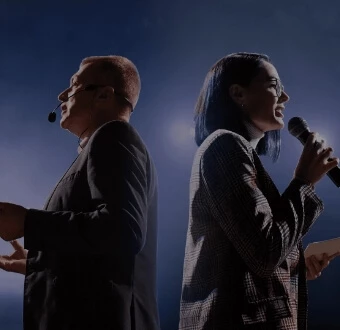 SPEAKERS
SPEAKERS
 TOPICS
TOPICS
Retro futurism depicts the future as envisioned in the past. It appears in film, music, modern art, architecture, fashion, interior design and many other areas of life.

Retro futurism is a celebration of people’s interpretation of the future, as depicted in the past. It’s the imagination of the future from different vantage points throughout history.
Over time, ideas about the future changed. In the 19th century, progress was very much centred on vehicles and an expansion of the factory system. Popular authors including H.G. Wells (The Time Machine), and Jules Verne (20,000 Leagues Under the Sea) explored these notions in detail.
In the late 20th century, ideas about the future morphed due to the emergence of mass computing and space travel. The Terminator, for instance, imagined humanity developing conscious machines. Star Trek saw humans journey deep into the cosmos.
Retro futurism, though, is found all over the place throughout the arts and sciences. It manifests in different ways as you look back through time.
As an art movement, retro futurism depicts how people in the past imagined the future. Painters and sculptors imagined zany scenes, from living on the Moon to experiencing flying saucer rides. In many cases, their visions were imaginations of the ultimate expression of technology of the time.

Many retro futurist artists depicted private helicopters and jets, hovercraft and personal space ships that we might recognise today. Others saw more mundane things, such as suspended highways, that were nonetheless remarkable concepts in the early 20th century.
Some more outlandish thinkers imagined what the world might look like deep into the 21st century. Painting what we might recognize today as Elon Musk’s Hyperloop. They saw a world of tubes that would connect cities offering ultrafast transportation.
Most retro futurist artists used Doo, Wop, Populuxe and Googie aesthetics. They often relied on neon colours, curvy geometries and cool steel in an attempt to convey futuristic sentiment.
In fashion, retro futurism was a trend that imagined the sort of clothes that people would wear deep into the future. This movement informed much of modern science fiction. It was particularly important when determining what actors on futuristic TV shows would wear on screen.
Many garments were either one-piece or skintight. Lighter tones and plastic boots were ubiquitous as most designers regarded plastic to be the material of the future.
Retro futuristic fashion began to become widespread in the 1990s. By the middle of the 2000s, it had become mainstream. However, whileoutfits were from distinct eras in the past. They’re now much more of a blend from the retro futuristic archive.
Retro futurism has also made its way into interior design. The trend first appeared in the mid-twentieth century. It has been making a quick comeback in more recent years, particularly from 2020 onwards.
Retro futuristic interiors rely heavily on cosmic lighting, unusual finishes and fluid shapes. They draw much of their inspiration from retro futuristic art and are commonplace in high-tech homes.

Verner Panton’s cantilevered Panton chair from the 1950s is a good example of emerging retro futurism in practice. The designer made the chair out of a single piece of plastic. This did away with the need for joinery required in traditional furniture making.
This idea that objects have to be singular became a trope of modern interior design. It even leached out into other areas such as electronics. From there onwards, waviness became the order of the day, impacting everything from coffee tables to crown moulding. Swooshing backdrops came to be synonymous with retro futuristism.
As you might expect, retro futurism also bled into video games. Due to many early game developers being fans of the genre as children during its 1950s to 1980s heyday).
Good examples of retro futuristic video games include:
There are some examples of retro futurism in architecture around the world, but they tend to be quite rare. Good examples of built environments include the

Many buildings feature curved facades and separate, UFO-like, space age adornments.
50’s retro futurism was born in the aftermath of World War II as new scientific discoveries were mad. Such as the computer, laser and rocket engine . For many critics, this was the beginning of the modern retro futuristic movement. It marked a clear break from the vintage futurism of the late nineteenth and early twentieth centuries.
The 1950s was the first time that people seriously began imagining what life would be like in space. Life in a Space Colony by Rick Guidice and Robert McCall was a good example of contemporary ideas. These artists imagined people living in giant donut-shaped objects spinning in space, offering inhabitants a type of artificial gravity.
1950s magazines also communicated a lot of futuristic concepts to the public. A special issue of Mechanix Illustrated from June 1957 is all about the housing of the future. People lived in round-walled buildings inside glass domes with underground parking for nuclear powered cars.
1980s retro futurism had a slightly different character and emerged significantly from the musical space. Modern electro style was in vogue with many artists, such as Aux 88, Cybotron and Drexcita. They all experimented with the new sounds that synthesisers could make. Many record labels supported the movement, such as Osman, Gosu and AMZS Recording, giving artists a platform they could leverage.
British band, Electric Light Orchestra, released a concept album called Time in 1980. The idea revolves around a man who wakes up in the year 2095. He now has to suddenly adapt to the world around him, whilst also longing to go back to 1981.
Today, there are both contemporary and retrospective retro futuristic films.
Examples of classic contemporary retro futuristic films include:
There are also examples of retrospective retro futuristic films: that base their aesthetics and themes on the 1950 to 1980 era.
Vintage futurism can refer to the 1950s to 1980s period. However it also stretches back to the earliest days of science fiction and technology driven inspiration about the future.
Vintage futurism began with the techno optimism of the nineteenth century. It was something of a golden era for technology. The motor vehicle, telegraph pole, photography and electricity all arrived at roughly the same time.
Early futurism was extremely abstract and not always based on near-term projections. It was more sceptical of what the future would be like and whether it would really lead to utopia. Therefore, the idea that technologies wouldn’t free human beings from their condition, was an underlying theme.
Retro futuristic non-fiction developed something of a cult following over the 20th century. Many of the ideas that authors developed were extremely unusual, even from today’s perspective.
Good examples of retro futurism in literature include:
Many of these books were adorned with retro futuristic art from some of the most innovative illustrators of the day. Hannes Bok, Jack Gaughan, Peter Haars, and Tom Hallman all produced covers for the above novels. Retro futurism was both futuristic but also slightly bleak. The outlook was often pessimistic.